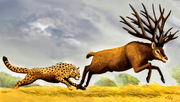The Giant Cheetah (Acinonyx pardinensis) is an extinct species of cheetah, widespread across Eurasia during the Pliocene and Pleistocene. It was a large species of felid related to (and significantly larger than) modern day African and Asiatic Cheetahs.
Description[]

Acinonyx pardinensis skeletal by Son of Sparda/Harpy Eagle Enthusiast
The Giant Cheetah is one of the largest known felines. Sexual dimorphism in Acinonyx pardinensis seems to be far higher than modern day cheetahs. Females weighed between 60 and 80 Kilograms (130 and 175 Pounds), meanwhile males weighed between 90 and 140 Kilograms (200 to 310 Pounds).[1][2] Higher estimates suggest 150 to 160 Kilograms (330 to 350 Pounds).[3]
The skull of A. pardinensis is also noticeably more robust than Cheetahs, although dentition seems to be somewhat similar.[1][4] The limbs are also more robust, in fact the ML Diameter is more comparable with modern day big cats than actual cheetahs themselves.[5]
Distribution and Subspecies[]

A map of the Giant Cheetahs Range
The giant cheetah has a huge range, one of the largest ranges of any large cat species currently known.
There are 4 known subspecies:
- Acinonyx pardinensis pardinensis: The most common of the 4 subspecies, specimens are known from Morocco, Spain, Germany, Italy, Bulgaria, Russia, Georgia, India, Kyrgystan, and China.
- A. pardinensis arvernesis: The second most common subspecies, known from Spain, Italy, Germany, Mongolia, Russia and China.
- Acinonyx pardinensis pleistocaenicus: Likely evolving from arvernesis, pleistocaenicus is mostly known from China with some specimens from Germany and France.
- Acinonyx pardinensis intermedius: The rarest subspecies, known from Germany, France, Austria and China.

Paleoart of the Giant Cheetah, seemingly showing pack hunting, even though that may be unlikely

Giant Cheetah hunting Eucladoceros by Hodari Nundra
Biology[]

Acinonyx Pardinensis by Roman Uchytel, assuming a spotted pattern
Modern day cheetahs seem to target similarly sized prey, Savannah Cheetahs in East-Kenya typically hunt Grants Gazelle, while Cheetahs in Kruger NP seem to focus on Impala, so it seems to be a consistency.[6][7] Due to this the Giant Cheetah most likely hunted similarly sized or even larger prey. Pantherine felids, which the Giant Cheetah still resembles in terms of morphology, do seem to hunt similarly sized or larger prey (With the exception of Jaguars, which likely evolved to hunt extinct Pleistocene megafauna).[8] Due to its large range prey likely varied, but animals like Red Deer, Elk, Przewalski's Horse and Wild Boars were likely on the menu.[9]
While originally thought to hunt by suffocation, recent studies suggest proper crushing of the back of the neck was the methodology used to kill prey.[5][1] Although male Cheetahs do make coalitions it is unknown if Giant Cheetahs did, it is unlikely however, due to no remains of several associate cheetahs in the massive range of this animal.
The limbs of the Giant Cheetah are extremely robust compared to its relative, so it likely wasn't as fast. Despite this it was still a fast animal, as most cat species are designed to kill prey in fast, powerful, bursts.[10]
Sources[]
- ↑ 1.0 1.1 1.2 https://www.sciencedirect.com/science/article/abs/pii/S0277379114000055
- ↑ https://onlinelibrary.wiley.com/doi/abs/10.1111/j.1502-3931.2006.00004.x
- ↑ https://twitter.com/BaryonyxWalker1/status/1764865411701486017
- ↑ https://www.sciencedirect.com/science/article/abs/pii/S0016699514000060?via%3Dihub
- ↑ 5.0 5.1 https://www.sciencedirect.com/science/article/abs/pii/S0277379111001703
- ↑ https://onlinelibrary.wiley.com/doi/full/10.1002/ece3.8556
- ↑ https://nsojournals.onlinelibrary.wiley.com/doi/full/10.2981/wlb.2004.024
- ↑ https://www.frontiersin.org/articles/10.3389/fevo.2015.00148/full
- ↑ https://x.com/BaryonyxWalker1/status/1764866723180626352?s=20
- ↑ https://www.nationalgeographic.com/science/article/life-in-the-slower-lane-revisiting-the-long-lost-giant-cheetah